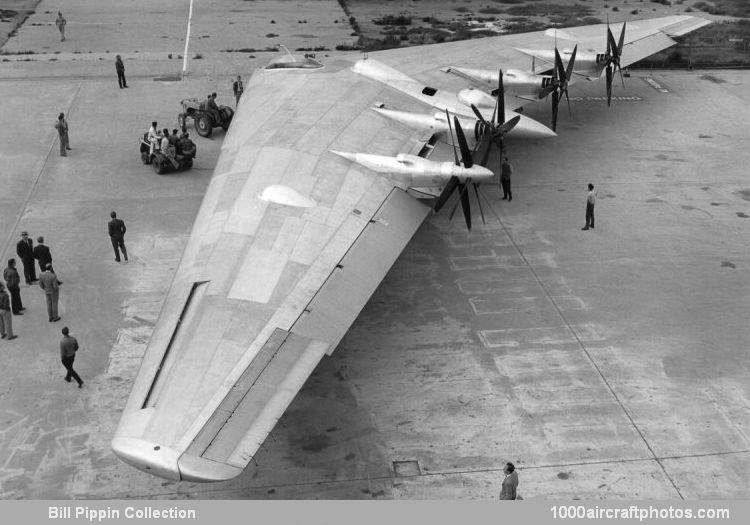07/31/2019. Remarks by Johan Visschedijk: "The XB-35 was the first in a series of large flying wing bombers. It would have an exceptionally long-range and heavy load capacity. Two XB-35 (s/n 42-13603, 42-38323) and thirteen YB-35s (s/n 42-102366 to 42-102378) were initially scheduled to be built under Army contracts. But only six of the big wing bombers were completed and test flown.
The XB-35 received its initial start from the USAAC in September, 1941, following a visit by Assistant Secretary of War Robert Leavitt, General H.H. Arnold, and Major General Oliver P. Echols. At this time, Northrop submitted a preliminary design tor the XB-35 to Wright Field. Army officials were more than satisfied because they awarded a contract for the altitude performance with a pressurized cabin for the crew and a more than adequate bomb load.
In November, 1941, two XB-35 prototypes were ordered by the Army Air Force. Preliminary design work began on the XB-35 early in 1942, and on July 5th of that year the mockup Board from Wright Field inspected a full size wood mockup of the center section and a portion of the left wing. Official approval was given. Northrop built a new bomber plant at the end of the company's grounds in Hawthorne, California. This plant was completed in January, 1943 and fabrication of the parts for the first XB-35 was begun.
The complexities of design in building the XB-35 represented an operation of major size. The Martin Company played a very important role by providing wind tunnel and other research data tor the XB-35 design. To provide flight test data, Northrop built four scale models, designated N9M. While the XB-35 was taking shape in the Hawthorne factory, thousands of test flights were run on the N9Ms to gather data which could be worked into the XB-35 design. This time-saving device enabled Northrop engineers to cut development time from the XB-35. Over the next three years flight tests were conducted at Muroc Army Air Base, California, to gather data while the XB-35 was taking shape.
The XB-35 used elevons which were installed on the trailing edges with landing flaps, trim flaps and rudders. The elevon was a Northrop invention in which the function of both elevators and ailerons were combined. Further control was achieved by wing slots.
The power plants of the XB-35 were 3,000 hp Pratt-Whitney Wasp Major engines, each with double turbo-superchargers. Inboard it had two 8-4360-17 engines that drove four coaxial contra-rotating four-bladed Hamilton Standard pusher propellers and outboard two R-4360-21 engines that turned the outer pair of propellers. The metal housing over the propeller shafts offered enough area to counter-act any yawing tendency of the flying wing design. Cooling air for the radial engines were ducted from openings in the leading edge of the wing. Tests were also run on three-bladed propellers, but the four-bladed models proved to be the most efficient. The aircraft was designed so that other types of engines could be adapted as they were made available.
The XB-35 was to have carried twenty 0.50 in (12.7 mm) machine guns: but these were not installed on the number one prototype XB-35. Seven remote-control gun turrets were aimed from central firing sighting stations behind the pilot and on top of the cone protruding from the trailing edge. Four gun turrets were fitted above and below the center section. Two gun turrets were visible outboard of the engines, one on top and one below. Four guns were to have been placed in the tail cone.
While the prototype XB-35s were built at the Hawthorne plant, a war time plan was begun to build 200 B-35s by Martin Aircraft Corporation at Omaha, Nebraska. Martin had previously built B-29 bombers, and it was expected that these would be phased out in favor of the B-35s. This program was dropped, however, with the conclusion of WW II.
After two years construction of the first prototype was in its final stage in April 1946, on May 25, 1946 (above) it was ready for its first taxi tests, while the same month it was shown to the public during an open house. On June 25, 1946, the world's first all flying wing bomber took to the air from Northrop Field at Hawthorne, California. The crew for this first flight, which ended at Muroc, were Northrop's Chief Pilot Max Stanley and flight engineer Dale Schroeder. The second prototype XB-35 first flew in November of 1946 and on June 26, 1947, it joined the first prototype at Muroc.
However, trouble developed in the engine reduction gear box arrangement and in the propeller governors of the XB-35s to such an extent that the eight contra-rotating propellers were replaced by four single-rotation four-blade propellers. The third aircraft, the first service test model, designated YB-35 (s/n 42-102366), was similarly equipped and joined the test force at Muroc on May 15, 1948. However, in November 1948 the USAF announced that the B-35 project would be abandoned in favor of the YB-49 all jet flying wing bomber. Of the original thirteen YB-35s ordered, four were scheduled to be used to supply spare parts for the extensive flight test program planned.
One YB-35 was to have been used as a test bed for the powerful Northrop XT-37 Turbodyne engine developed by the Turbodyne Corporation, a subsidiary of the Northrop Corporation. This project was dropped, however, when the Air Force ordered Northrop to divest itself from the manufacture of engines. All patents and manufacturing rights were later sold to the General Electric Company.
One YB-35 was slated to be turned over the US Navy and was to be designated XB2T-1; however, this did not take place. The Navy was to have flown and tested the aircraft for research purposes, but this project was cancelled."
